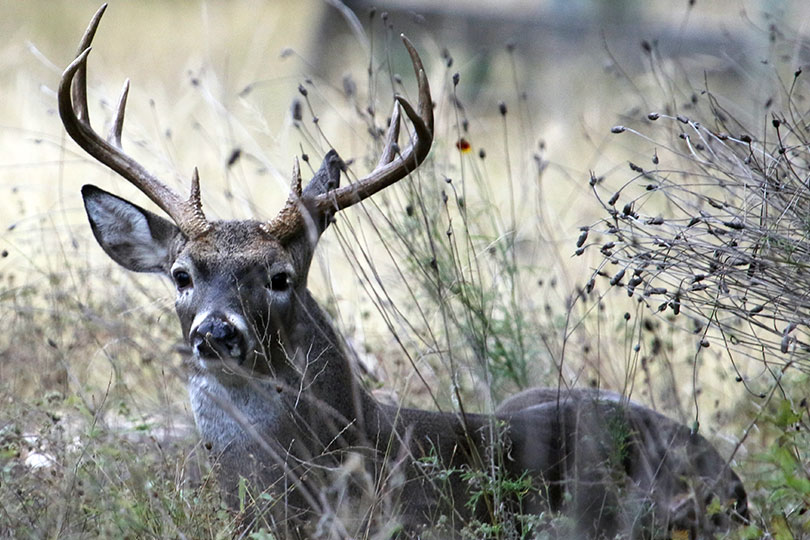By Jessica Domel
Multimedia Reporter
To give Texas hunters an opportunity to hunt white-tailed deer, mule deer, dove, quail, feral hogs and even exotics, the Texas Parks and Wildlife Department (TPWD) is now accepting entries for its Drawn Hunts.
Each year, TPWD issues about 10,000 permits in 60 hunt categories on public and private lands in Texas.
“By providing public hunting opportunities, Parks and Wildlife is basically putting into effect what it advocates to private landowners—that hunting is a key component to wildlife management in Texas,” Kelly Edmiston, TPWD’s public hunting coordinator for the wildlife division, said. “We have been involving the public in managing the resource on state run wildlife management areas since the 1950s.”
TPWD also offers hunts at state parks.
“Over the years, in addition to doing drawings on our own property, we assist the national wildlife refuges of Texas, and draw hunters for them,” Edmiston told the Texas Farm Bureau Radio Network. “The hunts take place on national wildlife refuges, and those hunts are administered by refuge staff rather than state staff, but we do the drawings for them. There are a lot of opportunities for somebody who is looking for a place to go or maybe a species they’re not normally hunting.”
There are hunts for alligator, exotic animals, feral hogs, javelina, mule deer, pronghorn, turkey, dove and quail.
There are guided hunts for bighorn sheep, gemsbok and scimitar-horned oryx.
“It’s not just a factor of what you can hunt but where,” Edmiston said. “Somebody who has never gone to the Panhandle or West Texas, we have areas out there they can apply to go and see—South Texas, East Texas and everything in between.”
There are also hunts specifically for youth and archery-only hunts available.
“For those particular individuals who prefer that method, those hunts are specifically geared toward archery,” Edmiston said. “What I mean by that is, very seldom are they a blind-type hunt. They’re more of what we call a compartment-type hunt where you’re basically given a section of that area, easily identified by fences or landmarks, and you can hunt within that compartment.”
The archery hunts are typically longer than other hunts.
“We have two different periods of hunts within our draws,” Edmiston said. “One is called a standard period, which normally starts at noon the first day and goes to noon the third day. You get two days worth of hunting distributed over three days.”
Extended hunts are typically four or five days long.
“Every one of our hunts involves an orientation where you meet with the other hunters selected for that hunt, and hunt staff go over the rules and regulations,” Edmiston said. “Then, at that particular point is when hunt blinds or hunt compartments are assigned.”
Hunters may then hunt for the rest of the day and the second day. The hunt usually ends around noon on the third day.
Application fees are free, $3 or $10, depending on the hunt category.
Adult hunters who are selected may need to pay a special permit fee of $80 for regular hunts or $130 for extended hunts.
Youth-only hunts require no application fees or permit fees.
Additional details on the hunts, the number of permits available, fees, the number of people who applied last year and the success rate, are available on the Drawn Hunts website.
Brochures for the hunting sites are also available on each hunt’s page.
In addition to the regular drawn hunts, TPWD also draws for e-postcard hunts.
“For a normal drawn hunt, you would make an application, pay an application fee, and if you were selected, would pay for a permit to go on maybe a three to five day hunt,” Edmiston said. “The public hunting program also has a walk-in program, and it involves the purchase of an annual public hunting permit. The annual public hunting permit gives individuals access to some of our properties where you don’t normally have to be drawn for. It’s more of a walk-in, open area.”
The private lands dove areas are like that, as are a few parks and wildlife management areas that allow general access.
“Those permits go on sale on Aug. 15 this year, just like our hunting and fishing licenses,” Edmiston said. “E-postcard draws are an additional opportunity to those who have an annual public hunting permit.”
Since an annual public hunting permit is required to apply for e-postcard hunts, entries for those will not be available until Aug. 15.
There is no fee to apply for an e-postcard hunt.
There are e-postcard hunts for deer, dove, feral hog, furbearers, multiple species, predator, quail, squirrel, teal, turkey, waterfowl and pheasant.
View a catalog of this year’s drawn hunts. You can search by hunt category or by area.
Application deadlines are the first and 15th of each month August through November.
Aug. 1 is the deadline for all alligator hunt categories and private lands dove hunts.
Aug. 15 is the deadline for archery deer, archery mule deer, pronghorn, private land pronghorn and javelina.
Hunters may apply up to 11:59 p.m. CST on the application deadline.
“Our public hunt system is pretty easy to use. It’s been in its current form since 2014, and it’s been very successful,” Edmiston said. “We also have a wildlife information line, here at Parks and Wildlife Headquarters, staffed by folks who can help you if you’re having any difficulties navigating it.”
The wildlife information line can be reached Monday through Friday from 8-5 at 512-389-4505.

